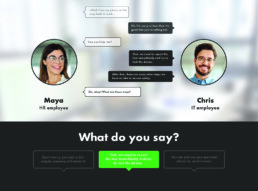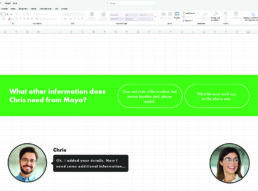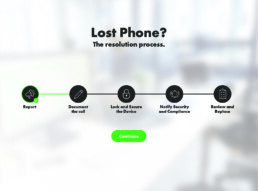
IT Incident Management
Learning from incidents - IT incident management with a system
How can IT incidents be handled in a structured and professional manner? This best practice shows the structure of an e-learning course on effective IT incident management. The training puts learners in the role of IT employee Chris, who receives various incidents and handles them according to a defined process. Each case starts with a short, realistic conversation to analyze the problem – then the correct handling of the situation is practiced, including documentation in the system and escalation if necessary. Theory elements are inserted at key points to deepen understanding. Each incident is self-contained and is told in a motivating short story. The special feature: The training can be flexibly expanded to include new cases – for sustainable, practical learning in the field of IT incident management.
The gap in IT training
The problem
Many IT incident management training courses rely heavily on theory: processes are explained in presentations, guidelines are provided in PDFs, and the emergency remains abstract. The problem with this is that in reality, incidents rarely follow a textbook approach. They start out unclear, are often emotionally charged and require quick but well-founded decisions – under time pressure. This is precisely where traditional training courses start too late or not at all. They explain what needs to be done, but not what it feels like to be in the middle of it. As a result, what has been learned remains theoretical, uncertainties remain in the event of an emergency and the transfer to everyday life is difficult. This best practice shows how interactive, scenario-based training with real case histories can close the gap between theory and practice – and finally bring IT incident management to life.


Skillpractice
The solution
Best Practice solves the weaknesses of traditional training courses by putting the learner right in the middle of the action: In the role of Chris, an IT employee in support, real incidents are actively dealt with – step by step, with all the challenges, queries and decision points. Instead of passively absorbing content, the learners accompany Chris in his daily work. They take responsibility, analyze situations, make decisions and directly experience the effects of their actions. Every incident begins with a real conversation – be it a phone call, an email or a spontaneous visit to his desk. This change of perspective turns abstract theory into tangible practice. Learners not only develop specialist knowledge, but above all confidence in their actions – and this is precisely what makes IT incident management effective.

From incident to improvement - the structured incident response process
To ensure that an IT incident is not only resolved but also dealt with in a sustainable manner, each case in the training follows a clearly defined process. From the initial contact with the problem to the risk assessment and solution through to informing the relevant departments – all steps are mapped in a practical way in the e-learning course. Lessons learned” is also an integral part of the training: not only is there a reaction, but also reflection. At the end, there is complete documentation – and the next incident can come.
This structured approach helps learners to systematically think through complex situations and promotes sustainable competence in IT incident management.

Correctly classifying incidents
An eye for the essentials
An IT incident rarely begins with a clear description of the problem. IT support is often confronted with vague information, emotional statements or technical layman’s descriptions. This is precisely what makes the first conversation in e-learning so valuable: in the role of Chris, the learner conducts a realistic conversation with the person reporting the problem. The aim is to filter out the relevant information in a targeted manner – without getting lost in trivialities. Learners train to ask specific questions, classify the problem correctly and recognize early on whether further measures or escalations are necessary. This turns a seemingly harmless conversation into the decisive first step in IT incident management.
The software simulation shows what really matters when recording incidents
From the conversation to the input screen
After the initial analysis of the incident, the aim is to accurately transfer the correct information to the IT systems. The software simulation in the e-learning shows step by step where which details need to be entered – and what information may still be missing. It becomes clear that not every piece of information from the interview is immediately relevant – but some is all the more so. Learners learn how to ask specific questions, fill in fields correctly and avoid typical mistakes when recording incidents. In this way, documentation does not become a compulsory task, but a structured part of the incident response process – comprehensible, professional and practical.


Step by step through the incident
Process view meets learning structure
In e-learning, each incident is divided into clearly structured steps – from the first contact to the final assessment. The progress remains visible to learners at all times. Whether the company cell phone has been lost or sensitive data has fallen into the wrong hands – each case follows a defined process that is clearly divided into individual chapters. This transparent presentation ensures that learners always know where they are and what comes next. At the same time, the ideal sequence of an incident response process is repeatedly displayed – as a reference point and guideline. In this way, the training combines confidence with a clear understanding of the underlying processes in IT incident management.
Learning impulses in the right places in the event of a malfunction
Theory, exactly when it is needed
Complex processes such as IT incident management depend on the right timing – and this also applies to learning. That is why e-learning does not deliver the relevant theoretical content in advance, but exactly where it is needed in the event of an incident. Like a short commercial break in a movie, the story is interrupted at selected touchpoints to provide background information, rules or special cases. In this way, learners not only understand what needs to be done, but also why. Special exceptions that are not included in the main story are also explained concisely here. These targeted theoretical impulses strengthen the understanding of the big picture – without disrupting the flow of action. This not only makes learning more effective, but also more sustainable.

From the first call to documentation - incident management you can take part in.

Interview with Günther Veit
What was the starting point for the development of this best practice?
In many companies, we see that IT incident management training is heavily rule-based – but there is often no connection to reality. There are processes on paper, but no practice in dealing with real incidents. Our aim was to change exactly that: We wanted to create a format that is practical, modular and directly applicable.
What makes the concept of this training special?
Clearly: the perspective. Learners slip into the role of an IT employee and experience typical incidents such as lost devices, compromised access data or internal security incidents at first hand. Each case is a mini-story that is realistically structured. The structured process – from acceptance and risk assessment to documentation – is followed. This creates a real feeling for the process.
Why did you opt for this scenario-based approach?
Because learning through experience simply works better. When I make decisions myself, take responsibility and see what information I am still missing, then a real understanding develops. And that is crucial, especially in the field of IT security.
Is there an element that you personally like in particular?
I think the theory impulses are great. They come exactly when you need them – like little breaks in the learning flow. I also like the fact that you can add new incidents to the training at any time. This keeps it lively and adaptable.
What would you recommend to companies that want to implement a similar topic?
I would advise them to collect real cases from their own company – in other words, situations that really happened. You can build wonderful stories from them. And then of course: less PowerPoint, more interaction. Learning has to feel like everyday life – then it sticks.
Online cybersecurity training – necessary and meaningful
Cybersecurity training online is not only possible, but more effective than expected - if…
Cybersecurity training online: What training should really achieve
A modern online cybersecurity training must do more than just warn. How e-learning…
e-Learning IT security: Why standard courses do not protect
e-Learning IT Security: How customized e-Learnings build awareness and real protection…
Online cybersecurity course for managers: responsibility starts at the top
Managers need customized online cybersecurity courses - for real responsibility and…
Online cybersecurity course: Why awareness alone is not enough
Online cybersecurity course: Strategic guidance for cybersecurity training. Why awareness…
IT security online course: these 5 mistakes to avoid
IT security online course: These mistakes should be avoided during development in order…
Cybersecurity online training with storytelling for real awareness
Cybersecurity online training with storytelling creates real awareness - why HR and…
Cybersecurity online course as a well thought-out curriculum
Curriculum-based cybersecurity online course concept: customized, adaptive content,…
Information security training as e-learning: protection for companies
Discover how customized information security training via e-learning works for large…









